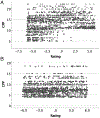Perceptual Evaluation of Vocal Fold Vibratory Asymmetry
- PMID: 34106487
- PMCID: PMC9476249
- DOI: 10.1002/lary.29679
Perceptual Evaluation of Vocal Fold Vibratory Asymmetry
Abstract
Objectives: Laryngeal vibratory asymmetry occurring with paresis may result in a perceptually normal or abnormal voice. The present study aims to determine the relationships between the degree of vibratory asymmetry, acoustic measures, and perception of sound stimuli.
Study design: Animal Model of Voice Production, Perceptual Analysis of Voice.
Methods: In an in vivo canine model of phonation, symmetric and asymmetric laryngeal vibration were obtained via graded unilateral recurrent laryngeal nerve (RLN) stimulation simulating near paralysis to full activation. Phonation was performed at various contralateral RLN and bilateral superior laryngeal nerve stimulation levels. Naïve listeners rated the perceptual quality of 182 unique phonatory samples using a visual sort-and-rate task. Cepstral peak prominence (CPP) was calculated for each phonatory condition. The relationships among vibratory symmetry, CPP, and perceptual ratings were evaluated.
Results: A significant relationship emerged between RLN stimulation and perceptual rating, such that sound samples from low RLN levels were preferred to those from high RLN levels. When symmetric vibration was achieved at mid-RLN stimulation, listeners preferred samples from symmetric vibration over those from asymmetric vibration. However, when symmetry was achieved at high RLN levels, a strained voice quality resulted that listeners dispreferred over asymmetric conditions at lower RLN levels. CPP did not have a linear relationship with perceptual ratings.
Conclusions: Laryngeal vibratory asymmetry produces variable perceptual differences in phonatory sound quality. Though CPP has been correlated with dysphonia in previous research, its complex relationship with quality limits its usefulness as clinical marker of voice quality perception.
Level of evidence: NA, basic science Laryngoscope, 131:2740-2746, 2021.
Keywords: Vibratory asymmetry; cepstral peak prominence; in vivo phonation; sort-and-rate; voice quality.
© 2021 The American Laryngological, Rhinological and Otological Society, Inc.
Conflict of interest statement
The authors have no other funding, financial relationships, or conflicts of interest to disclose.
Figures





References
-
- Woo P, Parasher AK, Isseroff T, Richards A, Sivak M. Analysis of laryngoscopic features in patients with unilateral vocal fold paresis. Laryngoscope 2016;126:1831–1836. - PubMed
-
- Sulica L Vocal fold paresis: an evolving clinical concept. Curr Otorhinolaryngol Rep 2013;1:158–162.
Publication types
MeSH terms
Grants and funding
LinkOut - more resources
Full Text Sources
Research Materials

